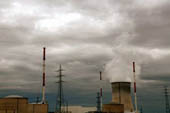
Purpose
To determine the amount of foreign particles in the air in a specific area.
Additional information
Breathing air is vital to our existence, but have you ever thought you might not be breathing purely clean air? This simple experiment will give you an idea of how “dirty” your air is.
Sponsored Links
Required materials
- White posterboard
- Scissors
- Vaseline
- String
- Hole punch
- Magnifying glass
- Permanent black marker
- Journal or notebook
Estimated Experiment Time
About a week.
Step-By-Step Procedure
- 1. Find an area in which you can hang several cut out pieces of the posterboard. You can do this in your home if you’d like to find out how clean the air in your home is, or you can hang the cut out pieces of posterboard outside in your yard or another area.
- 2. Cut the posterboard into several squares.
- 3. Draw a square with the marker on each cut out piece of posterboard, a little smaller than the square itself.
- 4. Punch a hole in the top of each piece of posterboard and tie pieces of string in the holes so you can hang the cut outs in various areas.
- 5. Smear a thin layer of Vaseline inside the drawn square on each cut out and hang them in different places within the area you’ve chosen. Record the areas you’ve hung each cut out in your notebook.
- 6. In about a week, collect your squares.
Note
You may need an adult’s help cutting and punching holes into the posterboard or hanging the cut out pieces of posterboard in high places so they are not disturbed.
Observation
With the magnifying glass, count how many particles you can see stuck to the Vaseline in each square. Record the number of particles, as well as the location of each cut out in your journal.
Result
You will most likely find some amount of particles stuck to the cut outs. Are there a lot of particles or just a few? How do you think the area you’ve chosen to perform the experiment in has affected your results? What do you think would happen if you performed this experiment in a heavily polluted area, such as a big city or an area with known air pollution? Do you think you would find more particles stuck to the cut outs? How do you think the particles in the air affects the air quality and our ability to breathe well?
Sponsored Links
Take a moment to visit our table of Periodic Elements page where you can get an in-depth view of all the elements,
complete with the industry first side-by-side element comparisons!